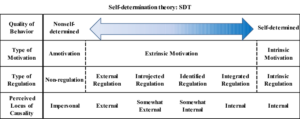Updated: 17 May, 2024
Have you ever wondered about the factors that drive your motivation and well-being in the workplace? Have you felt a strong sense of autonomy, competence, and connection with your work tasks? If so, you might have experienced the principles of the Self-Determination Theory influencing your work life. Coined and outlined by Deci and Ryan in the 1980s, SDT focuses on the fundamental psychological needs that propel individuals’ motivation and satisfaction. By understanding the core elements of SDT and its impact on workplace dynamics, you can uncover powerful insights that contribute to fostering a more motivated and fulfilled work environment. In this article, we’ll dive into the foundations of the Self-Determination Theory and explore how applying its principles can enhance both your own engagement and that of your employees in the workplace.
What is the Self-determination theory and how does it affect work?
Self-determination theory emerged in 1985 through the collaborative efforts of Edward Deci and Richard Ryan, presented in their seminal work titled “Intrinsic Motivation and Self-determination in Human Behavior.” This theory is rooted in the notion that humans are inherently curious, dynamic, and driven individuals, actively seeking personal growth and development. Nevertheless, there are instances when these positive attributes may not be readily apparent in individuals.
Self-determination theory dives into the contextual elements that either grow or hinder self-motivation and personal growth. It achieves this by looking into the fundamental principles of intrinsic motivation, which refers to the innate inclination of individuals to actively seek novelty and challenges, explore their capabilities, and engage in continuous learning and self-development.
What are the factors that affect motivation at work?
Self-determination theory asserts that individuals must attain three core psychological demands at work to fuel intrinsic motivation. In 2010, Van den Broeck et al developed the Work-related basic needs satisfaction scale (W-BNS), an 18-item scale influenced by the recognized psychological needs of SDT, to assess these three requirements:
- Autonomy: Autonomy refers to the need to feel a sense of choice, independence, and self-direction in one’s actions. Individuals value having the freedom to make decisions that align with their preferences and values. By allowing employees the freedom to take charge of their responsibilities, autonomy fosters a sense of ownership. This, in turn, intensifies job satisfaction, as individuals find fulfillment in adapting their tasks to their strengths and preferences.
Embracing autonomy empowers employees to harness their skills and creativity, thereby fostering higher-quality work and increased innovation. The encouragement of diverse approaches to tasks enriches the potential for novel solutions. Additionally, autonomy lays the groundwork for innovation and creativity. By liberating individuals from rigid frameworks, it encourages them to explore unconventional ideas and contribute to an organizational culture that embraces novelty.
- Competence: In the context of work, competence encompasses the pursuit of mastering skills, taking on challenges, and attaining a sense of proficiency that contributes to a person’s self-esteem and engagement. The impact of nurturing competence within the workplace is both profound and multifaceted.
- Relatedness: Relatedness encompasses the need for social connection, belonging, and positive relationships with others. Individuals thrive when they feel connected to and supported by their social environment.
How are we motivated to work?
Organizations that embrace the principles of SDT recognize that intrinsic motivation is the foundation of innovation, productivity and job satisfaction. Instead of solely depending on external rewards and punishments, they create an environment that encourages employees to discover joy and fulfillment in their work. By nurturing the three main factors of motivation, these organizations cultivate a workforce that doesn’t just get driven but becomes inspired to give their best every day.
What are the different types of motivation?
Self-determination theory categorizes different types of motivation along a continuum, ranging from intrinsic motivation (the most self-determined) to extrinsic motivation (various levels of external influence).

The self-determination continuum, with types of motivation, types of regulation, and locus of causality. Adapted from Deci, E. L., and Ryan, R. M., (Eds.)
Intrinsic Motivation
This is the highest level of self-determination, where individuals engage in activities purely for the inherent satisfaction and enjoyment they provide. They find the activity itself fulfilling and stimulating.
Intrinsic motivation stands as the highest form of self-determination within the framework of the Self-Determination Theory. It embodies the essence of genuine passion and internal drive. When individuals are intrinsically motivated, they engage in activities solely for the inherent joy, satisfaction, and curiosity that these activities bring. The motivation arises from within, making the activity its own reward.
For ongoing engagement, well-being, and personal progress, intrinsic motivation is crucial. In order to grow intrinsic motivation, companies and educators must offer possibilities for autonomy, promote discovery, and emphasize the importance of the activity itself rather than relying primarily on external rewards.
Extrinsic Motivation
Extrinsic motivation involves engaging in activities due to external factors, such as rewards, recognition, or avoidance of punishment. While extrinsic motivation can range from more autonomous to more controlled forms, it’s less self-determined than intrinsic motivation.
Integrated Regulation
Integrated regulation reflects a higher level of internalization of external factors. In this form of motivation, individuals incorporate external values, beliefs, and goals into their own sense of self. They engage in activities because they have personally assimilated the importance of those activities. For instance, an individual might partake in regular exercise not only because they enjoy it, but also because they recognize the long-term health benefits it brings, aligning with their personal values.
Identified Regulation
Identified regulation involves engaging in activities because they align with personally valued goals and objectives, even if the activities themselves might not be inherently enjoyable. Individuals engage in these activities as a means to achieve outcomes that are important to them. For example, someone might study diligently for an exam because they identify the significance of education and learning in achieving their career aspirations.
Introjected Regulation
Introjected regulation refers to acting under internal pressure or in an effort to suppress uneasiness or guilty sentiments. Even though the inspiration comes from within, it is not totally self-determined. Even though the duties they perform may not be in line with their true inclinations, people may perform them out of a sense of obligation or to uphold their self-esteem. If they are not genuinely inspired by the assignment, someone may put in extra time to avoid feeling bad about leaving things unfinished.
The Work-Related Basic Needs Satisfaction Scale
The Work-Related Basic Need Satisfaction Scale is the scale used to measure the Self Determination theory developed by Deci and Ryan. It was developed in accordance with the concepts to the SDT and attempts to understand and assess aspects of people’s motivation and well-being at work.
Deci and Ryan proposed the SDT however it lacked the means to measure such a theory, therefore, researchers from the University of Belgium and Ghent, (Broeck, A., et. al. 2010) developed a scale which allowed measurement and proved to be extremely helpful towards research and practice. It examines key aspects to determine how well the basic psychological needs for autonomy, competence, and relatedness are satisfied in the workplace.
Autonomy
The W-BNS used by SARA to measure employees’ perceptions of their level of autonomy at work. The survey’s questions probe how much discretion employees feel they have in making decisions, how much control they feel they have over their work, and how empowered they feel in doing so. HR consultants can learn a lot from the insights gathered from employees’ answers to these questions. Furthermore, with the help of this data, they are able to identify places where people might feel constrained and make adjustments to cultivate an environment that is more empowering.
Example Question: “To what extent do you feel you have the freedom to make decisions about how you perform your job tasks?”
Competence
The survey includes questions focused on employees’ perceptions of their competence and skill development within the organization. These questions evaluate employees’ sense of mastery in their job, the learning and growth opportunities available to them, and whether they perceive their abilities as recognized and effectively utilized. Assessing competence helps HR consultants identify areas where employees may need additional support or training to enhance their effectiveness.
Example Question: “Do you feel that your current role allows you to use and develop your strengths and abilities effectively?”
Relatedness
SARA incorporates questions that explore the sense of belonging and social connection among team members in the workplace. Additionally, these questions assess the quality of relationships between colleagues, the level of support and cooperation within the team, and the overall sense of camaraderie and inclusivity. Understanding relatedness can help HR consultants identify any potential issues with team dynamics and foster a more supportive and cohesive work environment.
Example Question: “How would you rate the level of collaboration and support among your team members?”
Try the W-BNS Scale for Yourself
Finally, do you wonder how you score on autonomy, competence and relatedness compared to other people in your industry, role or age group? Try taking the W-BNS on SARA by following this link.
We also made scales for The Utrecht Work Engagement Scale (blog linked here & survey linked here) based on researchers Schaufeli, Bakker, and Salanova. The UWES measures work engagement of employees using several statements. The information received can then be used to improve organisations and personal goals.
Additionally, the survey we offer developed from Kahn’s studies of the psychological conditions required for personal engagement at work show great potential when assessing personal development, and motivation incentives. (Blog linked here & survey linked here)
All surveys allow you to compare your engagement levels to those of other people in your age group, industry and job role as well as get suggestions on how to improve.
What tool did we use for these surveys?
These surveys run on our Survey Analysis and Report Automation system, SARA in short. SARA allows HR consultants to either use standard surveys such as these or create their own surveys and methodologies to serve their clients. Reach out to us if you want to find out more about all the possibilities with SARA.







